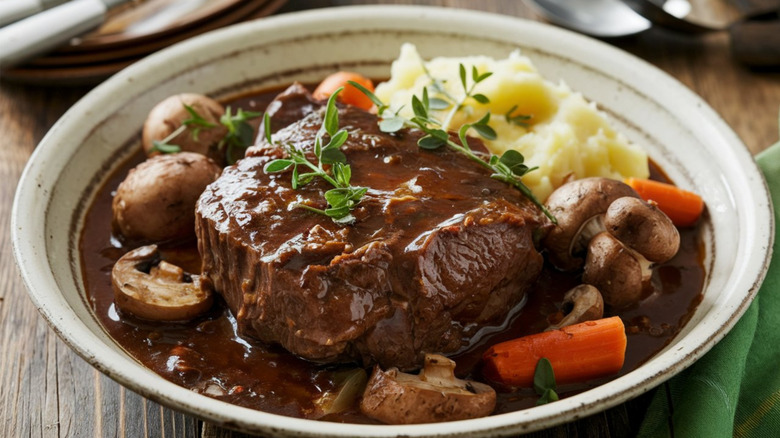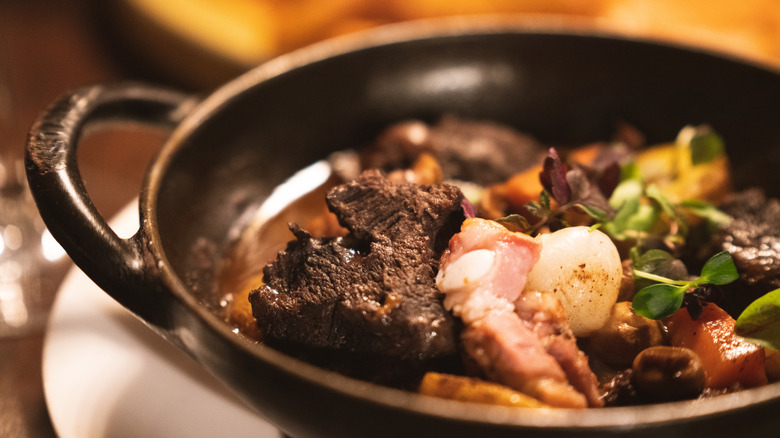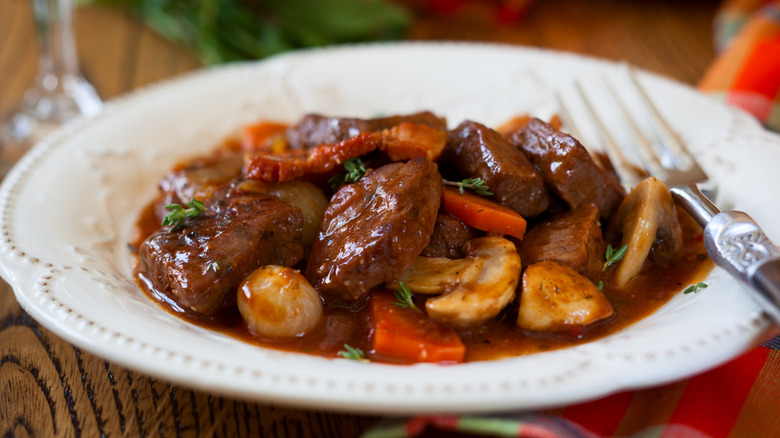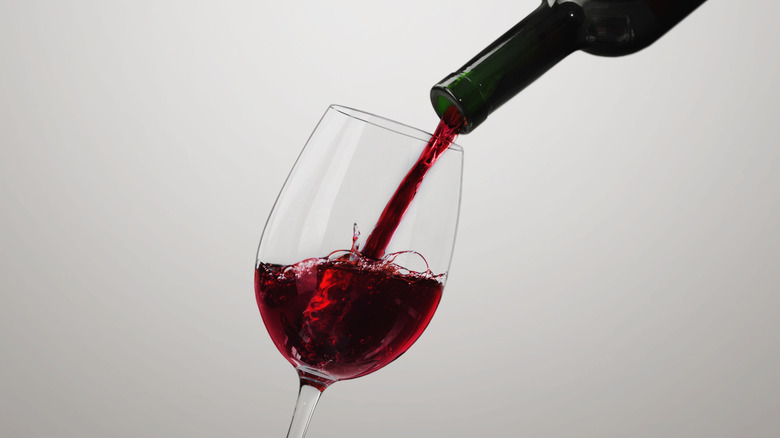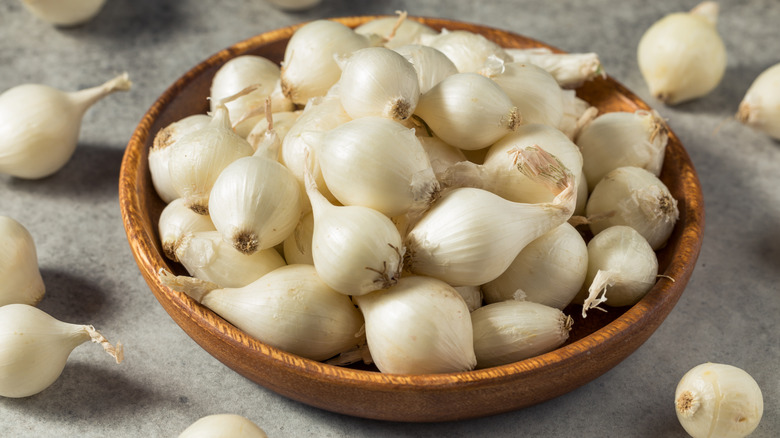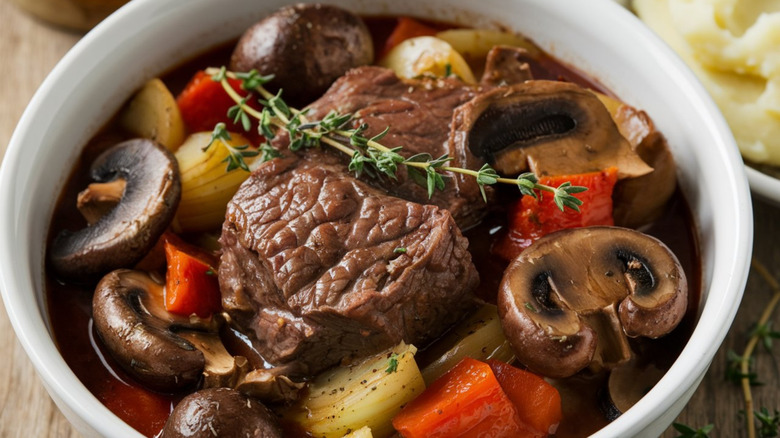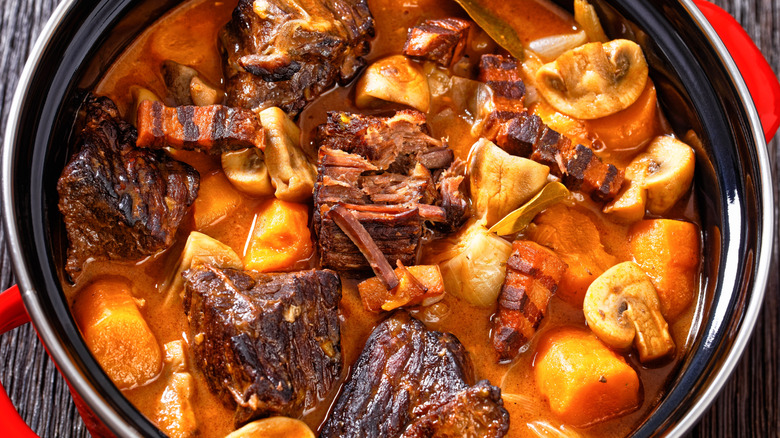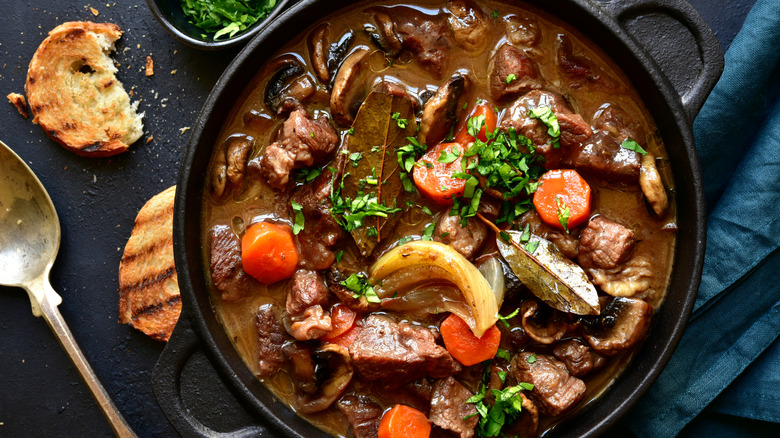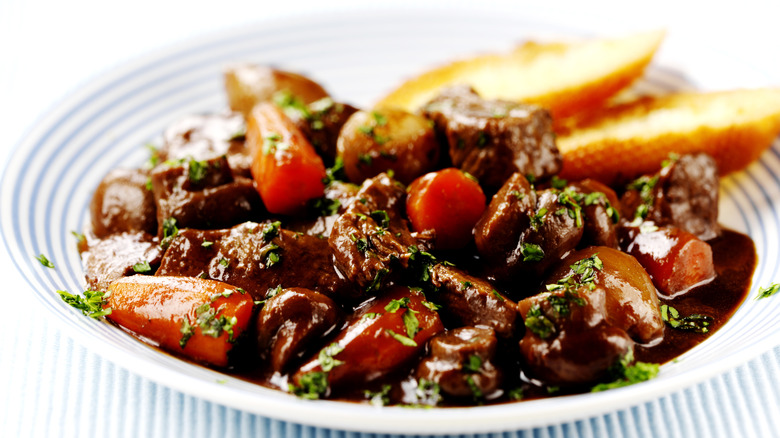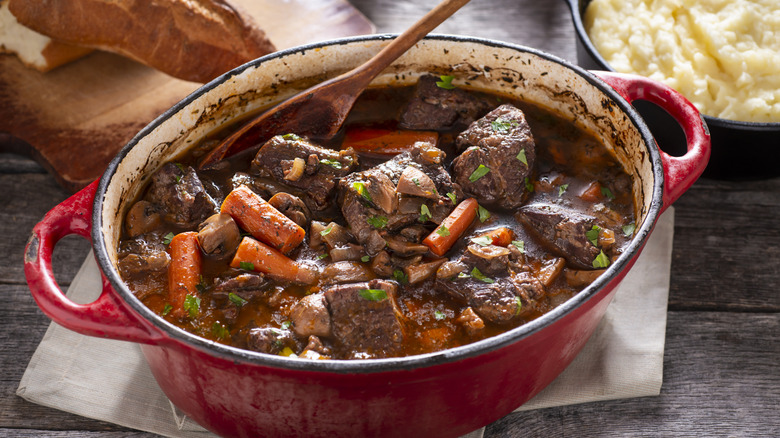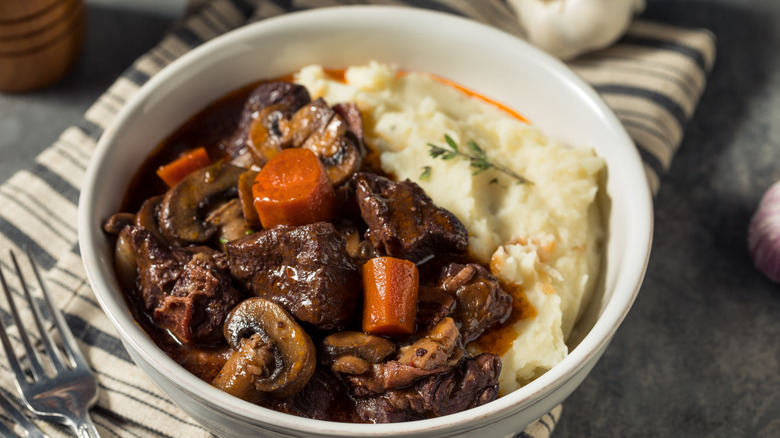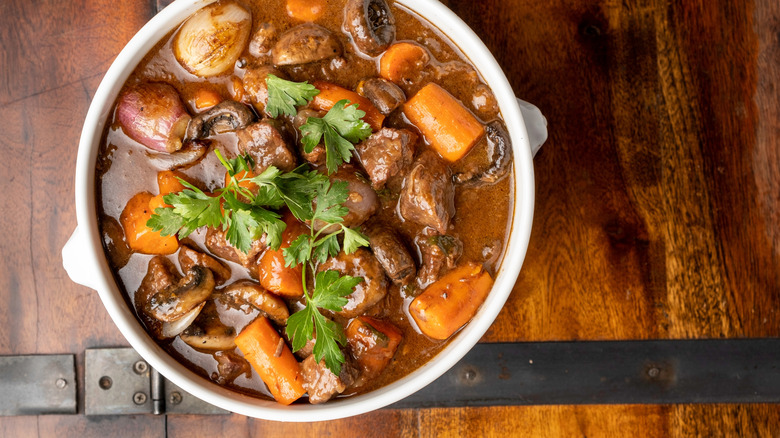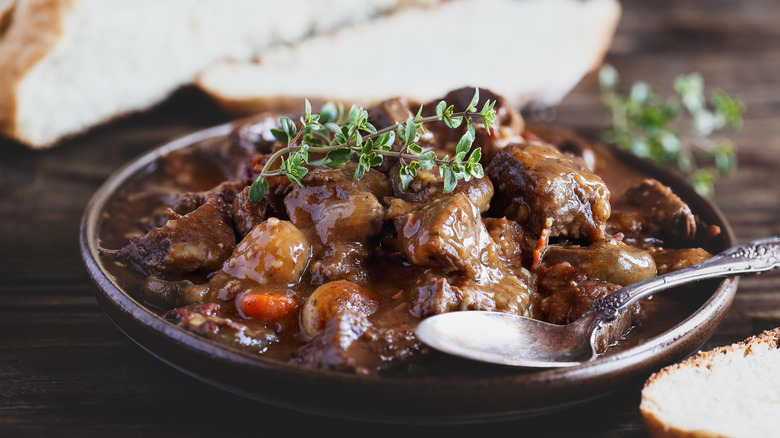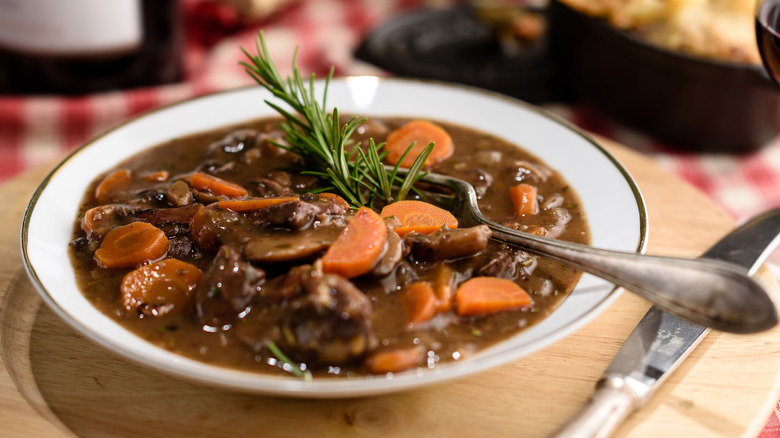13 Tips You Need To Cook The Best Beef Bourguignon
A classic French dish, beef bourguignon is also a fantastic warm, comfort food you can enjoy anywhere. It may have a reputation as being a tricky recipe to prepare, but this rustic beef dish doesn't need to include any special tools or tricks. By knowing how to shop for the best ingredients and ways to make the most of them as you put together your beef bourguignon, you can also master French cuisine.
We talked to Makenna Held, CEO of RecipeKick and founder of Courageous Cooking School. Held lives and teaches in Julia Child's former home in the South of France, where she prepares one of the famous chef's most iconic dishes and teaches others how to do the same (plus plenty of other tasty French fare). She helps home chefs master delicious recipes using what they have in their home kitchen, embracing techniques that don't require a culinary degree or specialized equipment. Here are some of the best tips and tricks to make this amazing dish at home.
Buy high quality meat
The first step to a great beef bourguignon starts at the butcher counter when you pick out your meat. Look for plenty of marbling, since this helps keep the meat tender and flavorful as it cooks. Even though you'll be adding other ingredients with tons of flavor, starting with a high-quality cut is key. USDA Prime is a top-rated cut that has even marbling.
Julia Child famously made beef bourguignon on her cooking show. She recommended using chuck because the meat gets tender without becoming stringy. When making beef bourguignon on The French Chef, Child cut the larger cuts into smaller portions for the stew. You can do this yourself at home or ask the butcher to prepare a custom cut for you.
Makenna Held shared that "a good beef stew is always about fork-tender beef." Don't overlook the importance of getting a good cut that will add flavor to the end result without drying out. If a top cut isn't in the budget, don't worry. Braising is a good opportunity to get away with a slightly cheaper cut if needed. Because this method gets the meat super tender, even tougher cuts can become delicious and savory when braised.
Get a cut that can cook low and slow
The key to tender beef bourguignon is to cook it over low heat for plenty of time. Chunk roast is a favorite among chefs because it is economical but cooks well over low heat and gets super tender. But getting the perfect cut is only half of the equation. You'll need to let it cook slowly to get the best results. Fortunately, chuck roast works well when prepared this way since the fat in the meat melts, giving the dish plenty of flavor.
Makenna Held recommends taking it easy with the heat from the very beginning when you brown the meat. While you may be tempted to turn things up in order to get a crispy crust on the exterior of your cut, doing too much can be counter-productive to the tender, balanced stew that you want.
"The biggest mistake I see people make is over-browning your meat, and searing it to too deep of a color," she said. "You just need some Maillard magic to occur, but don't need a thick crust." The Maillard reaction combines heat, protein, and sugar to create a distinctly savory flavor. This is what adds depth to the meat and the sauce, which is why it is important to beef bourguignon preparation. But you don't need to take things as far as you might when preparing steak, since you want to keep the meat super tender as well.
Use a dry red wine
Red wine, such as Burgundy, Pinot Noir, or Côtes du Rhône, work well in beef bourguignon. The traditional option is Burgundy, made in the same region where the dish was created, but you can use any deep red. The key is to get a dry red rather than something too sweet.
Makenna Held takes a casual approach to cooking with wine when preparing beef bourguignon. "A lot of people have opinions on what is right vs. wrong, and as a champion of the home cook I am a firm believer that being specific is utterly unnecessary," she said. "For it technically to be a Bourguignon it has to be from Burgundy, which means for red it should be a wine made with Pinot Noir or Gamay grapes, but if you have a merlot you love? It won't fail you!"
To make the most of your ingredients, choose a wine that you'd enjoy drinking as well. Serving it alongside your beef bourguignon will ensure that the flavors pair well together.
Add aromatics
Traditional beef bourguignon starts with an aromatic base, which you can prepare as the beef cooks in the oven. Onions give a sweet and savory depth when cooked until translucent. Braise pearl onions early in the cooking process to bring out these flavors. If you can't find fresh pearl onions, you can use frozen ones or substitute a different kind of diced onion. "Use a very aromatic homemade stock, and the type of herbs you use in the stew itself are far less important," said Makenna Held.
Use a very aromatic homemade stock, and the type of herbs you use in the stew itself is far less important. For pearl onions, be careful when peeling them, and try to leave the onion intact. They work well whole in the hearty stew, where they add a sweet flavor. When braised, pearl onions become tender rather than crunchy and lose much of the acidic bite. "Traditionally Beef Bourguignon is carrots, onions, and some mushrooms," adds Held. "Often all stewed together with beef, some bacon, beef stock, wine, and some aromatics." It's this combination of ingredients melded together that transforms the dish into a magical stew, starting with the onions.
Marinate the beef
Let the beef marinate in the wine overnight to give it extra time to get even more tender. The wine helps break down the tougher fibers while imparting that taste to the beef. If you're using a tougher cut, marinating it in wine can help pre-tenderize the meat even before you begin cooking. You can also add garlic and herbs to give it extra flavor. Use the same ingredients you plan to put in the stew to help it all med together even more. Just be sure not to reuse your marinade when making your sauce. Start with fresh wine or broth when putting your beef into the oven to cook.
Even though you can use a marinade to get the meat ready for cooking, it isn't best to take it straight from the marinade to the pan. You should dry your beef before browning. If the beef is still wet, the Maillard reaction will not occur and you'll end up steaming the meat instead. Even though it doesn't need a crispy crust, it should still brown in the pan to get the delicious bits that add so much flavor to the dish.
Dry the beef and mushrooms
The key to creating a super flavorful crust when you sear the meat is to dry it ahead of time. Any extra moisture can cause the meat to steam rather than sear. The same goes for your mushrooms, which you should rinse and dry before sautéeing. All you need to do is pat them dry with a paper towel before putting them in the pan.
If you've used a marinade, it's important to take time to dry the meat because it will have soaked up extra liquid. Don't worry about changing the flavor since that remains even if the exterior is ready for searing. The flavor of the marinade, whether it's wine, broth, or herbs, will infuse into the meat as it marinates and gives subtle depth to the final stew.
Once it is browned, transfer the meat to a Dutch oven to finish braising. It doesn't need to have the same crispy crust that a seared steak will have, but should still get brown enough to impart delicious flavor to the beef bourguignon. For the mushrooms, get them brown on the exterior but don't overcook them to the point of being mushy. You can keep them separate from the rest of the stew and add them to the final dish toward the end of cooking.
Cook the beef in small batches
One major mistake that can make your beef less tasty is trying to sear it all at once, crowding the meat together in the pan to brown it. The beef should be touching the hot skillet and there should be enough room to shift the meat around as it browns. This might mean you cook it in small batches and put it all together later in the cooking process.
If you rush this step, you might end up stacking or overlapping the beef. The result will be cuts that don't cook evenly and less browning than you'd get if you take your time. Because this is where so much of the flavor comes from for the sauce, it is a critical part of preparing beef bourguignon. Alternatively, you could cook the beef in more than one pan at the same time, since it does not need to be closely monitored or taken off the heat at a precise time. As long as it is evenly browned and not overcooked, you'll get a tasty cut that is fork-tender in the end.
Don't forget to deglaze
Once the beef is done searing, deglaze the pan with wine or stock to get the brown bits off the bottom. It adds this flavor back into the broth. Julia Child's version uses red wine to deglaze, adding extra depth to the flavor. It also helps to keep your ingredients list shorter and more manageable by using what you already have. However, you can use any liquid, including stock or broth. Even water will work to deglaze, although it doesn't add the same taste that other options do.
You should deglaze right away while the pan is still hot to get all of the cooked bits off the bottom. You may need to use a spatula to get some of the most stubborn parts off, but don't be afraid to scrape a bit to get every last bit. In addition to helping enrich the taste of your dish, it will make cleanup a little bit easier, too. Pour the resulting wine-based liquid over your beef in a Dutch oven and transfer it to the oven to continue cooking.
Don't forget the veggies and fungi
Beef bourguignon may have a reputation as a fancy dish in America but in its French home, this is a simple, country stew that is more homey. Makenna Held dubbed it a "granny dish" in France, although it is still one of the national favorites. Large chunks of carrots give a rustic feel to this hearty comfort dish. Let them get fork-tender for the best taste and texture. Mushrooms are another essential that can bring a hearty texture to the dish alongside the meat. Brown them just like you do the meat to get the best flavor out of these fungi.
Held departs from the traditional recipe with her own beef bourguignon, incorporating new ingredients to give it her own spin. "I love beet in my bourguignon," she said. "It's a sweet addition, and adds a depth of color that moves the dish from red brown to a deep blue toned red that delights."
Prepare the mushrooms for texture
When sautéeing your mushrooms for beef bourguignon, use oil and butter in the pan. This helps you get browned mushrooms for flavor without burning. Julia Child's version calls for home chefs to quarter the mushrooms to keep them large enough. This allows the mushrooms to hold their own in the stew to make a big impact on both taste and texture.
Makenna Held opts to make her mushrooms separately from the rest of the dish. "I prefer not to put my mushrooms into the stew until the bitter end, and cook them separately before stirring them in," she said. "It's a great way to ensure they don't mush into the melée and hold some delicious texture." One of the best things about beef bourguignon is how well all of the ingredients work together and this only happens if they are all hearty enough to make their mark.
Make sure the sauce is thick
Beef bourguignon is a stew, so the sauce should be as hearty as the chunkier ingredients. Remove the finished beef from the Dutch oven to put the finishing touches on the sauce before reassembling the entire dish. Taste it to see if it needs a small seasoning adjustment and evaluate the thickness of the final sauce.
"I prefer to use a paper lid, often called a cartouche in French, over a metal lid as I want liquid to evaporate in order to thicken the sauce," said Makenna Held. "You can also fake a thick sauce with some flour, but I prefer to avoid flour where possible."
If you add flour to the sauce, create a slurry by adding it to cold water and incorporating that mixture into the stew. This keeps it from clumping while also letting the sauce get thicker.
Don't rush the process
Beef bourguignon is a dish that takes time and patience, so don't rush the beef. It should cook over low heat for 2 to 3 hours until it is super tender. If you try to speed things up by browning the meat more on the stove, you won't get the delicious and savory meat you want. The same goes for the braised onions, browned mushrooms, and sweet carrots.
The finishing steps are also important. Makenna Held credited the great garnishes that Julia Child used with developing the chic reputation that Americans associate with beef bourguignon. "Julia Child's recipe is quintessential in so many ways, and is often people's favorite," she said. "I think this is primarily due to garnish, as her version has four garnishes which elevates this staple to new heights."
Even though she prefers to focus on the aromatic base over the type of herbs, Held also noted that "nothing finishes a stew off better than a hit of fresh thyme leaves." This garnish adds brightness in both flavor and visual appeal to this rich, hearty dish.
Finish steps ahead of time
While beef bourguignon can be an intimidating dish, there are many steps that you can finish a day or more in advance. This allows you to assemble this delicious stew to serve it to guests or enjoy yourself, even if you're short on time. This is the perfect dish to make ahead of time then put together moments before heating and serving. You can also make the entire dish from start to finish and keep leftovers in the fridge. The flavors meld together even more as it rests.
Depending on how much fat melts off the beef and into the sauce, you may need to skim the top layer off the final dish. The vegetables can be browned and cooked ahead of time. ou may want to wait until the day of cooking since they do not take a lot of time and can be easier to work with when they are freshly prepared.
